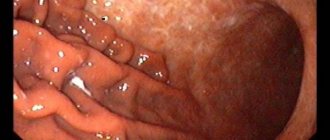Causes of bloody vomiting
Blood in vomit is a sign of internal bleeding. Moreover, the stronger it is, the higher the risk of death. Although hidden bleeding is also no less dangerous to human life. Therefore, in any case, you need to urgently contact the clinic. Perhaps this is a manifestation of one of the ailments:
- Mallory-Weiss syndrome . Males are most susceptible to this disease. The pathology develops against the background of existing changes in the walls of the stomach resulting from physical strain or injury. Debilitating vomiting, bouts of hiccups or coughing force the walls of the organ to strain, while small lesions begin to increase in size and rupture, which is why blood appears. If the vomit contains not just inclusions, but entire blood clots, we can assume the presence of blunt trauma. Treatment of the syndrome is usually conservative, but in some cases surgical intervention is required.
- Acute stage of peptic ulcer . Drinking alcoholic beverages with a stomach ulcer is fraught with serious consequences. The veins of the esophagus, stomach, and duodenum expand under the influence of increased pressure, which can lead to damage. When a peptic ulcer worsens, the vomit contains a large number of red clots or resembles a fountain of blood. As a rule, this happens after taking a large dose of alcohol. The patient requires urgent hospitalization; in severe cases, surgery is performed.
- Internal varicose veins . In the case of bloody clots of a bright scarlet hue, we can talk about internal varicose veins. This disease is characterized by bleeding of the walls of the throat of the stomach or esophagus. The situation gets worse when drinking alcohol. Weak vessels, unable to withstand high pressure, begin to burst. The blood mixes with food debris and alcohol, causing the vomit to turn light red. Conservative therapy is carried out.
- Cirrhosis of the liver . This is a rather serious pathology, which usually develops against the background of prolonged consumption of alcoholic beverages. In the damaged organ, disturbances in the outflow of venous blood occur, which is why hematemesis occurs. Increased pressure on the veins of the esophagus leads to their expansion, damage and, as a result, bleeding. As a rule, it is this serious complication of cirrhosis that leads to death. Therefore, for people suffering from such a disease, alcohol, even in small quantities, is strictly prohibited.
- Exacerbation of gastritis . With this disease, drinking alcohol is generally contraindicated, since after drinking heavily, a person may vomit blood. Such bleeding, as a rule, is not too profuse, but you still have to visit a gastroenterologist.
How does bile get into vomit?
Bile is a liquid that is produced by liver cells. It has a specific smell and bitter taste. Depending on the time of its production, its color changes. 67% of the composition of the digestive fluid is represented by cholic and chenodeoxycholic acids.
It contains metal ions (lead, mercury, copper, zinc, magnesium), vitamins B, A, C and a number of organic substances (bilirubin phospholipids, lecithin, cholesterol, mucin). Thanks to these components, bile participates in the following processes:
- neutralization of pepsin;
- emulsification of fats;
- activation of hormone secretion by intestinal cells;
- formation of feces;
- improvement of intestinal motility;
- preventing bacterial adhesion.
Insufficient production of liver secretions leads to disturbances in the digestive process. The place of its accumulation is the gallbladder.
When digested grains of food enter the stomach, bile begins to be released, which mixes with them and begins to perform its main function.
The pylorus of the stomach, located at its outlet, prevents its penetration into the organ. In case of nutritional disturbances, the development of diseases in the body, or the presence of harmful substances, the pyloric sphincter opens, allowing liver secretions into the stomach. The body tries to get rid of toxins, provoking bouts of vomiting.
If the phenomenon occurs frequently and is accompanied by other symptoms, then you need to consult a doctor.
Predisposing factors and symptoms
The appearance of impurities can be caused by additional reasons . Vomiting of bile with blood can occur in the following conditions:
- Damage to the throat or esophagus;
- drug overdose;
- the presence of infectious intestinal lesions;
- internal abdominal injuries;
- poisoning of the body with toxic substances or alcohol;
- development of oncology in the gastrointestinal tract, metastases.
In some cases, vomit that looks like bloody foam may be a sign of lung damage. Sometimes the vomit takes on a dark tint, which clearly indicates the presence of bleeding in the gastrointestinal tract. Blood entering the stomach mixes with food debris, gastric juice and hydrochloric acid. Gradually, it accumulates in the gastric cavity and, under the influence of the chemical reactions that occur, changes color to black or dark brown. When the stomach fills with blood, a person’s reflex is triggered and he may vomit.
Black vomit after alcohol indicates mild gastric bleeding. If the blood does not have time to change color, it can be assumed that the stomach is filling too quickly. In any case, the patient requires urgent hospitalization, otherwise he may die.
Recommendations
To eliminate the disease, it is first necessary to normalize intestinal function. It is imperative to prevent the formation of bile sediment. The diet should contain only healthy foods. These include:
- pears;
- honey;
- dried apricots;
- prunes;
- watermelons;
- carrot;
- pumpkin;
- zucchini.
The menu should include whole grain porridge, fermented milk products, jelly, and butter. It is these products that restore the intestinal microflora and eliminate inflammation of the gastric mucosa. As a result, bile will not release all its contents into the digestive organs.
It should be clarified that the release of bile into the stomach is not a disease. First of all, it is necessary to find the reasons for its occurrence. To do this, it is necessary to make an accurate diagnosis of the body. In some cases, specialists use complex therapy. An individual program helps restore all vital functions. The correct approach of a specialist and the prescription of systematic treatment contribute to the patient’s recovery in a matter of time.
Signs of internal bleeding
Vomiting blood is not the only symptom of internal bleeding. This condition is also characterized by the following symptoms:
- dizziness;
- pale skin tone; with severe blood loss, the skin may become bluish;
- darkening of the eyes;
- feeling of thirst and dry mouth;
- drowsiness, loss of strength and general weakness of the body;
- black loose stools;
- lowering blood pressure;
- reduction in the volume of urine produced;
- rapid breathing;
- tremor of the upper extremities.
Be carefull! Particularly dangerous is a condition characterized by the following symptoms:
- decreased visual acuity;
- the appearance of cold sweat;
- cardiopalmus;
- disorientation in space;
- fainting, usually occurs with significant blood loss;
- incessant pain in the abdominal cavity, debilitating vomiting.
In severe cases, the patient may fall into a coma.
Signs of the presence of bile in vomit
The presence of liver secretions in the stomach is indicated by the following signs:
- nausea and heartburn;
- stomach ache. Discomfort can be felt in different areas, and the degree of its intensity depends on the type of toxin and the severity of the pathology;
- belching accompanied by an unpleasant odor;
- covering the tongue with a yellow coating;
- dry mouth that does not go away after drinking liquid;
- a feeling of bitterness in the mouth that persists for a long period of time;
- increased salivation;
- bloating;
- lack of appetite;
- headache;
- frequent breathing.
Additional signs depend on the type of pathology.
In case of intoxication, a person's temperature may rise. Diseases of the liver and gall bladder are characterized by a yellow color of the skin and sclera of the eyes, the patient complains of severe itching. With intestinal obstruction, constipation occurs.
The accompanying symptoms of this phenomenon may resemble signs of pathologies, therefore, to find out the correct cause of its occurrence, it is necessary to undergo examination by a gastroenterologist.
First aid
If a person begins to vomit blood after drinking, you should immediately call an ambulance. While waiting for paramedics to arrive, begin providing first aid. It must be remembered that the methods used for alcohol poisoning and hangover (cleansing enema, taking sorbents, etc.) are absolutely unacceptable in this case. Such actions will only lead to increased damage to the vessel and increased bleeding, which is fraught with large blood loss. First aid for hematemesis involves the following:
- First of all, it is necessary to create a calm environment for the patient. Lay him on the bed, while raising his legs up.
- If a person has fallen into an unconscious state, the patient's head should be turned to the side, which will avoid the accumulation of blood in the lungs and the tongue sinking.
- Ice should be placed on the abdominal area. This will help slow down the bleeding.
- Monitor the patient's breathing and pulse. If necessary, immediately begin chest compressions.
Patients suffering from liver cirrhosis or peptic ulcer are at risk. Therefore, relatives should consult with a specialist in advance about providing first aid to such patients. The doctor may recommend keeping a solution of aminocaproic acid in your home medicine cabinet, which is given to the patient for such bleeding. The dosage of the drug is determined only by the doctor; independent use of the drug is strictly prohibited.
Visit of specialists to your home
First of all, doctors assess the general condition of the patient. They measure the respiratory rate, blood pressure, pulse, level of oxygen in the blood, get acquainted with the medical history, and collect an anamnesis. Before hospitalization, a number of measures are taken to improve the patient’s condition. First aid involves the following actions:
- to provide intravenous access, a special catheter is inserted into the vein;
- to increase the volume of circulating blood, the doctor prescribes intravenous hemostatic drugs;
- The patient is connected to a machine that supplies oxygen.
The patient is then rushed to the hospital.
Mechanism of development of vomiting
In the brain there is a so-called vomiting center: a collection of numerous nerve nuclei that receive impulses from the cardiovascular system, stomach, esophagus and intestines, as well as the limbic system - structures responsible for memory, emotions, sleep and wakefulness. The vomiting center is washed by cerebrospinal fluid, into which chemicals from the blood penetrate, so vomiting (emetic syndrome) often accompanies various poisonings. It is affected by intracranial pressure, so an increase or decrease in the latter also causes vomiting.
Emetic syndrome is a protective reflex. It is necessary to cleanse the stomach of toxic contents that have entered it and avoid intoxication of the body. Also, the syndrome is a signal for a person to find and eliminate the existing problem.
During pregnancy, emetic syndrome occurs due to the following reasons:
- diseases of the stomach and intestines;
- pathologies of the liver, pancreas and bile bladder;
- excessive stress;
- adrenal insufficiency;
- food or chemical poisoning;
- intracranial hypertension or, less commonly, hypotension;
- heart diseases (including myocardial infarction, for example, its painless form);
- diseases of the vestibular apparatus;
- diseases accompanied by intoxication: tonsillitis, sinusitis, pneumonia.
But in the early stages of pregnancy, vomiting can be an almost “normal” phenomenon that occurs in response to an increase in human chorionic gonadotropin hormone in the blood. And the more of this hormone (for example, with multiple pregnancies), the more pronounced the emetic syndrome is.
Diagnostic measures
To make an accurate diagnosis, it is necessary to conduct a series of examinations, including both laboratory and instrumental diagnostics. First of all, the following diagnostic measures are carried out:
- thorough examination of the patient;
- a detailed survey of the patient regarding the presence of concomitant diseases, as well as the intensity of the main symptoms;
- study of medical history and anamnesis.
Carry out diagnostics. Laboratory examinations are as follows:
- general urine analysis;
- biochemical and clinical blood tests;
- vomit tests;
- microscopic examination of feces, which, in addition to particles of undigested food and particles of fat, may contain blood streaks.
If the cause of the appearance of blood in the vomit is gastroenterological pathology, then this can be identified using instrumental examinations:
- radiography;
- MRI and CT;
- Ultrasound of the abdominal organs;
- FEGDS.
If necessary, the doctor prescribes additional diagnostics, which depend on the suspected cause of hematemesis.
Can there be black vomit and is it dangerous?
Black vomiting may be a sign of a serious pathology or have a physiological cause. Some foods turn vomiting black: chocolate, berries with dark pulp, etc. Knowing about their consumption on the eve of vomiting, you can only focus on relieving this unpleasant symptom.
Diseases that cause bleeding in the gastrointestinal tract:
Neoplasms of any etiology (tumors, polyps);
Trauma to the mucous membrane of the stomach or intestines;
Ulcerative lesions of the stomach or small intestine;
Side effects of drugs that can cause damage to the stomach or intestines (Indomethacin, Aspirin, Ibuprofen, drugs, steroid hormones);
Prevention of vomiting blood
Of course, it is better that such a situation does not happen again. To prevent vomiting blood, you must follow these rules:
- ensure proper rest and a balanced diet;
- give up bad habits and lead a healthy lifestyle;
- take medications as prescribed by the doctor, with mandatory adherence to the daily dosage;
- avoid injury to the abdominal cavity;
- undergo regular medical examinations, especially for people at risk.
How does vomiting occur?
The process of eruption of food from the stomach is a reflex act. The action is controlled by the vomiting center from the medulla oblongata. A defensive reaction occurs immediately as soon as toxic substances enter the body. More often they enter through the stomach. Poisonous gas vapors penetrate the respiratory tract.
In both cases, the body's defense reaction is triggered. The brain receives an alarm signal through the blood that a dangerous substance has entered the body. The vomiting center transmits the command to the stomach, which contracts and throws out the contents.
How is the treatment carried out?
Before you begin treatment, you need to find out exactly why you are vomiting blood after drinking alcohol and what needs to be done about it.
If internal bleeding occurs against the background of an existing disease, no home or folk remedies will help. In the absence of medical care, a person most often dies. Elimination of vomiting blood involves the following measures:
- Temporary refusal to eat. On the second day after the onset of blood vomiting, you can eat steamed dishes. Subsequently, the usual diet is gradually restored.
- Gastric lavage.
- Administration of antispasmodic, antidiarrheal and antipyretic drugs.
- Electrolyte balance is restored by introducing water-salt solutions.
- The patient is given decoctions of medicinal plants - plantain and calendula, rose hips and mint, lemon balm and chamomile.
It is very important to ensure rest for the entire period of treatment. Moreover, it is necessary to avoid not only physical activity, but also emotional shocks. Treatment of gastroenterological pathologies requires an individual approach. As a rule, such diseases are treated conservatively. If there was a large loss of blood, a blood transfusion may be prescribed; in case of severe dehydration, an IV is placed. In severe cases, surgery is required.
Diet during treatment
After normalization of the condition, as soon as the patient stops vomiting, he is allowed to take liquid, pureed, warm food without using products that can provoke re-bleeding and exacerbation of the existing pathology. It is strictly prohibited to include pickled, spicy, fatty, canned, sour and fried foods in the diet, as well as raw fruits and vegetables, and red meat. The menu may consist of the following dishes:
- jelly;
- weak tea;
- liquid pureed porridge cooked in water or weak chicken broth.
All dishes are given only in small quantities. As soon as the patient’s well-being begins to improve, pureed chicken and meat puree, as well as soft-boiled eggs, can be added to the diet. At the same time, the amount of food consumed is gradually increased.
A gentle diet must be followed even after complete recovery; alcohol consumption should be avoided.
Possible complications
Vomiting with blood is a rather dangerous condition, as it can provoke the development of serious complications:
- pneumonia;
- dehydration of the body;
- state of shock;
- anemia (with heavy blood loss);
- attacks of suffocation;
- convulsive seizures.
The appearance of vomiting in any case is a signal of ongoing disorders in the human body. Therefore, you should not ignore this symptom, especially if the vomiting is gushing in nature and includes even a small amount of bile or blood. In order to prevent such a condition, when frequent and long-term alcohol consumption leads to damage to tissues, internal organs, blood vessels and veins, measures should be taken to get rid of addiction.
Treatment for vomiting bile
If the disorder is permanent, you should consult a doctor. The gastroenterologist will select a course of therapy based on the examination results. To determine the root cause of the disease, tests of biological materials and hormone testing may be prescribed. If gastritis is suspected, gastroscopy is performed.
Violating doctor's orders is prohibited. This will only lead to worsening of the condition and relapse. During therapy, there are general rules: follow a diet, stop drinking alcohol, eat regularly and in standard portions. Also, many doctors recommend high-quality enzymes of organic origin, for example Papaya Enzyme
Drug therapy
Medicines are prescribed after identifying the cause of vomiting. Simple enterosorbents are often recommended. They allow you to cope with intoxication during poisoning and after drinking alcohol - for example, Atoxil and Stimol.
If an attack of vomiting is caused by a stressful condition, you need to take tranquilizers based on benzodiazepines. Betahistine and Lorazepam relieve stomach cramps and quickly soothe.
If an intestinal infection is detected, antibiotics cannot be avoided. Sumamed and Azithromycin in the form of powder, gel or tablets for oral administration are prescribed for 3-10 days until the symptoms of the disease are completely relieved.
ethnoscience
Tinctures and decoctions are allowed only during the recovery period, when it is necessary to replenish the volume of fluid in the body, as well as calm the nervous system and mucous membrane.
After stopping vomiting, if there are no contraindications, it is recommended to drink a glass of ginger tea, water with 1-2 tablespoons of baking soda, liquid with a few drops of lemon.
The solutions act as absorbents, eliminate the unpleasant bitter taste in the mouth and stimulate the restoration of water-salt balance. You cannot resort to these methods in the acute stage of gastritis, ulcers and irritable bowel syndrome.











